Effects of Common Biochar and Acid-Modified Biochar on Growth and Quality of Spinach in Coastal Saline Soils
Abstract
1. Introduction
2. Results
2.1. Spinach Growth Conditions
2.2. The Fresh Weight and Dry Matter
2.3. The Ratio of Root to Shoot and Healthy Strong Seeding Index
2.4. Spinach Yield
2.5. Total Water Consumption and Water Productivity
2.6. Spinach Photosynthetic Characteristics
2.7. Spinach Qualities
2.8. The IBRv2 Calculation
3. Materials and Methods
3.1. Tested Soil, Materials, and Acid-Modified Biochar Preparation
3.2. Experimental Site and Design
3.3. Observation and Measurement
3.4. Data Analysis and Statistics
4. Discussion
5. Conclusions
Author Contributions
Funding
Data Availability Statement
Conflicts of Interest
Correction Statement
References
- Ministry of Natural Resources, People’s Republic of China. Major Data Communique of the Third National Land Resource Survey. 2021. Available online: https://mnr.gov.cn/dt/ywbb/202108/t20210826_2678340 (accessed on 16 January 2023).
- Li, E.; Shen, J.; Ju, J.; Hu, H.; Lu, X. Distribution characteristics of salinity and nutrient at the estuary in coastal saline soil of north Jiangsu. Sci. Soil Water Conserv. 2016, 14, 79–88, (In Chinese with English Abstract). [Google Scholar] [CrossRef]
- Dong, Y.; Chen, R.; Yu, B.; Yao, R.; Feng, Y.; Lin, X. Improvement and mechanism of maize straw on microbial activity in coastal moderately saline soils. Chin. J. Appl. Environ. Biol. 2022, 29, 394–400, (In Chinese with English Abstract). [Google Scholar] [CrossRef]
- Wang, Z.; Heng, T.; Li, W.; Zhang, J.; Zhang, L. Effects of subsurface pipe drainage on soil salinity in saline-sodic soil under mulched drip irrigation. Irrig. Drain. 2020, 69, 95–106. [Google Scholar] [CrossRef]
- Glaser, B.; Haumaier, L.; Guggenberger, G.; Zech, W. Black carbon in soils: The use of benzene carboxylic acids as specific markers. Org. Geochem. 1998, 29, 811–819. [Google Scholar] [CrossRef]
- Duan, M.; Li, Z.; Liu, G.; Zhou, B.; Wang, Q.; Tan, Z.; Meng, H. Effects of modified biochar on adsorption and distribution of Cu2+ in soil. Environ. Pollut. Control 2021, 43, 150–155, (In Chinese with English Abstract). [Google Scholar] [CrossRef]
- Jian, M.; Gao, K.; Yu, H.; Yang, Y. Comparison of surface characteristics and cadmium solution adsorption capacity of un-acidified or acidified biochars prepared from rice straw under different temperatures. Ecol. Environ. Sci. 2015, 24, 1375–1380, (In Chinese with English Abstract). [Google Scholar] [CrossRef]
- Bai, J.; Song, J.; Chen, D.; Zhang, Z.; Yu, Q.; Ren, G.; Han, X.; Wang, X.; Ren, C.; Yang, G.; et al. Biochar combined with N fertilization and straw return in wheat-maize agroecosystem: Key practices to enhance crop yields and minimize carbon and nitrogen footprints. Agric. Ecosyst. Environ. 2023, 347, 108366, (In Chinese with English Abstract). [Google Scholar] [CrossRef]
- Chen, Z.; Kamchoom, V.; Apriyono, A.; Chen, R.; Chen, C. A laboratory study of water infiltration and evaporation in biochar-amended landfill covers under extreme climate. Waste Manag. 2022, 153, 323–334. [Google Scholar] [CrossRef]
- Higashikawa, F.; Silva, C.; Carducci, C.; Jindo, K.; Kurtz, C.; De Araújo, E.; Sousa, R.; Alves, D. Effects of the application of biochar on soil fertility status, and nutrition and yield of onion grown in a no-tillage system. Arch. Agron. Soil Sci. 2023, 69, 212–227. [Google Scholar] [CrossRef]
- Li, F.; Wang, D.; You, Y.; Li, G.; Eltohamy, K.M.; Khan, S.; Riaz, L. The application of biochar mitigated the negative effects of freeze-thaw on soil and nutrient loss in the restored soil of the alpine mining area. Front. Environ. Sci. 2022, 10, 1053843. [Google Scholar] [CrossRef]
- Pu, S.; Li, G.; Tang, G.; Zhang, Y.; Xu, W.; Li, P.; Feng, G.; Ding, F. Effects of biochar on water movement characteristics in sandy soil under drip irrigation. J. Arid Land 2019, 11, 740–753. [Google Scholar] [CrossRef]
- Zhang, Y.; Wang, J.; Feng, Y. The effects of biochar addition on soil physicochemical properties: A review. Catena 2021, 202, 105284. [Google Scholar] [CrossRef]
- Cui, L.; Liu, Y.; Yan, J.; Hina, K.; Hussain, Q.; Qiu, T.; Zhu, J. Revitalizing coastal saline-alkali soil with biochar application for improved crop growth. Ecol. Eng. 2022, 179, 106594. [Google Scholar] [CrossRef]
- Edith, C.H.; Manfred, F.; Matthias, C.R.; Josef, K. Biochar increases arbuscular mycorrhizal plant growth enhancement and ameliorates salinity stress. Appl. Soil Ecol. 2015, 96, 114–121. [Google Scholar] [CrossRef]
- Zhang, K.; Song, X.; Guo, D.; Huang, S.; Yue, K.; Guo, T.; Zhang, S.; Yue, Y. Effects of biochar on fertility and nitrogen utilization efficiency in Fluvo-Aquic Soil. J. Henan Agric. Sci. 2022, 51, 73–80. [Google Scholar] [CrossRef]
- Xu, J. Effects of Biochar of Soil Properties of Maize and Greenhouse Gas Emissions. Master’s Thesis, Shenyang Agricultural University, Shenyang, China, 2017. (In Chinese with English Abstract). [Google Scholar]
- Guo, S.; Yang, W.; Song, S.; Chen, Y.; Yang, M.; Hui, C.; Zhang, J. Change in photosynthesis of spring wheat with irrigation amount and biochar amendment. J. Irrig. Drain. 2023, 42, 65–73, (In Chinese with English Abstract). [Google Scholar] [CrossRef]
- Wang, X.; Cai, G.; Lu, X.; Yang, Z.; Zhang, X.; Zhang, Q. Inversion of Wheat Leaf Area Index by Multivariate Red-Edge Spectral Vegetation Index. Sustainability 2022, 14, 15875. [Google Scholar] [CrossRef]
- Schad, P.; Huyssteen, C.; Michéli, E. World Reference Base for Soil Resources 2014: International Soil Classification System for Naming Soils and Creating Legends for Soil Maps; Organización de las Naciones Unidas para la Alimentación y la Agricultura (FAO): Rome, Italy, 2014. [Google Scholar]
- Sanchez, W.; Burgeot, T.; Porcher, J.M. A novel ‘Integrated biomarker response’ calculation based on reference deviation concept. Environ. Sci. Pollut. Res. 2013, 20, 2721–2725. [Google Scholar] [CrossRef]
- Ali, L.; Wang, X.; Naveed, M.; Ashraf, S.; Nadeem, S.; Haider, F.; Mustafa, A. Impact of biochar application on germination behavior and early growth of maize seedlings: Insights from a growth room experiment. Appl. Sci. 2021, 24, 11666. [Google Scholar] [CrossRef]
- Claudia, I.K.; Sebastian, L.; Johannes, W.G.; Hans, W.K. Influence of biochar on drought tolerance of Chenopodium quinoa Willd and soil–plant relations. Plant Soil 2011, 345, 195–210. [Google Scholar] [CrossRef]
- Rosa, E.; Mulyadi; Prasetyo, M.; Aziz, A.; Bakar, B.A.; Panikkai, S. Utilization of rice husk biochar and tofu dregs compost to growth and yield of sweet corn (Zea mays saccharata Sturt.). IOP Conf. Ser. Earth Environ. Sci. 2020, 484, 012056. [Google Scholar] [CrossRef]
- Pradhan, S.; Mackey, R.H.; Ansari, A.T.; Mckay, G. Biochar: A sustainable approach for water stress and plant growth. Int. J. Glob. Warm. 2021, 25, 425–439. [Google Scholar] [CrossRef]
- Sarwar, N.; Abbas, N.; Farooq, O.; Akram, M.; Hassan, M.W.; Mubeen, K.; Rehman, A.-U.; Shehzad, M.; Ahmad, M.; Khaliq, A. Biochar integrated nutrient application improves crop productivity, sustainability and profitability of maize–wheat cropping system. Sustainability 2023, 15, 2232. [Google Scholar] [CrossRef]
- Yang, L.; Liao, F.; Huang, M.; Yang, L.; Li, Y. Biochar improves sugarcane seedling root and soil properties under a pot experiment. Sugar Tech. 2014, 1, 36–40. [Google Scholar] [CrossRef]
- Xie, W.; Zhi, C.; Li, Q.; Zhao, Y.; Geng, L.; Zhang, L.; Liu, W.; Li, B. Effects of biochar on the restoration of secondary salinized soil in the greenhouse. Chin. J. Soil Sci. 2019, 50, 407–413, (In Chinese with English Abstract). [Google Scholar] [CrossRef]
- Huang, C. Effects of Common Biochar and Acid-Modified Biochar on Soil Water and Salt Distribution and Spinach Growth in a Tidal Flat Area. Master’s Thesis, Yangzhou University, Yangzhou, China, 2021. (In Chinese with English Abstract). [Google Scholar] [CrossRef]
- Akhtar, S.S.; Andersen, N.M.; Liu, F. Biochar mitigates salinity stress in potato. J. Agron. Crop Sci. 2015, 201, 368–378. [Google Scholar] [CrossRef]
- Wang, J.; Huang, C.; Feng, S.; Liu, C.; Li, H.; Han, Q. Using biochar amendment to improve the physicochemical properties of soil in coastal tidal area. J. Irrig. Drain. 2022, 41, 125–130, (In Chinese with English Abstract). [Google Scholar] [CrossRef]
- Mohsen, J.; Lello, Z.; Sara, R. Low temperature tolerance in plants: Changes at the protein level. Phytochemistry 2015, 117, 76–89. [Google Scholar] [CrossRef]
- Premalatha, R.P.; Malarvizhi, P.; Parameswari, E. Effect of biochar doses under various levels of salt stress on soil nutrient availability, soil enzyme activities and plant growth in a marigold crop. Crop Pasture Sci. 2022, 74, 66–78. [Google Scholar] [CrossRef]
- Chu, G.; Zhao, J.; Huang, Y.; Zhou, D.; Liu, Y.; Wu, M.; Peng, H.; Zhao, Q.; Pan, B.; Christian, E.W. Phosphoric acid pretreatment enhances the specific surface areas of biochars by generation of micropores. Environ. Pollut. 2018, 240, 1–9. [Google Scholar] [CrossRef]
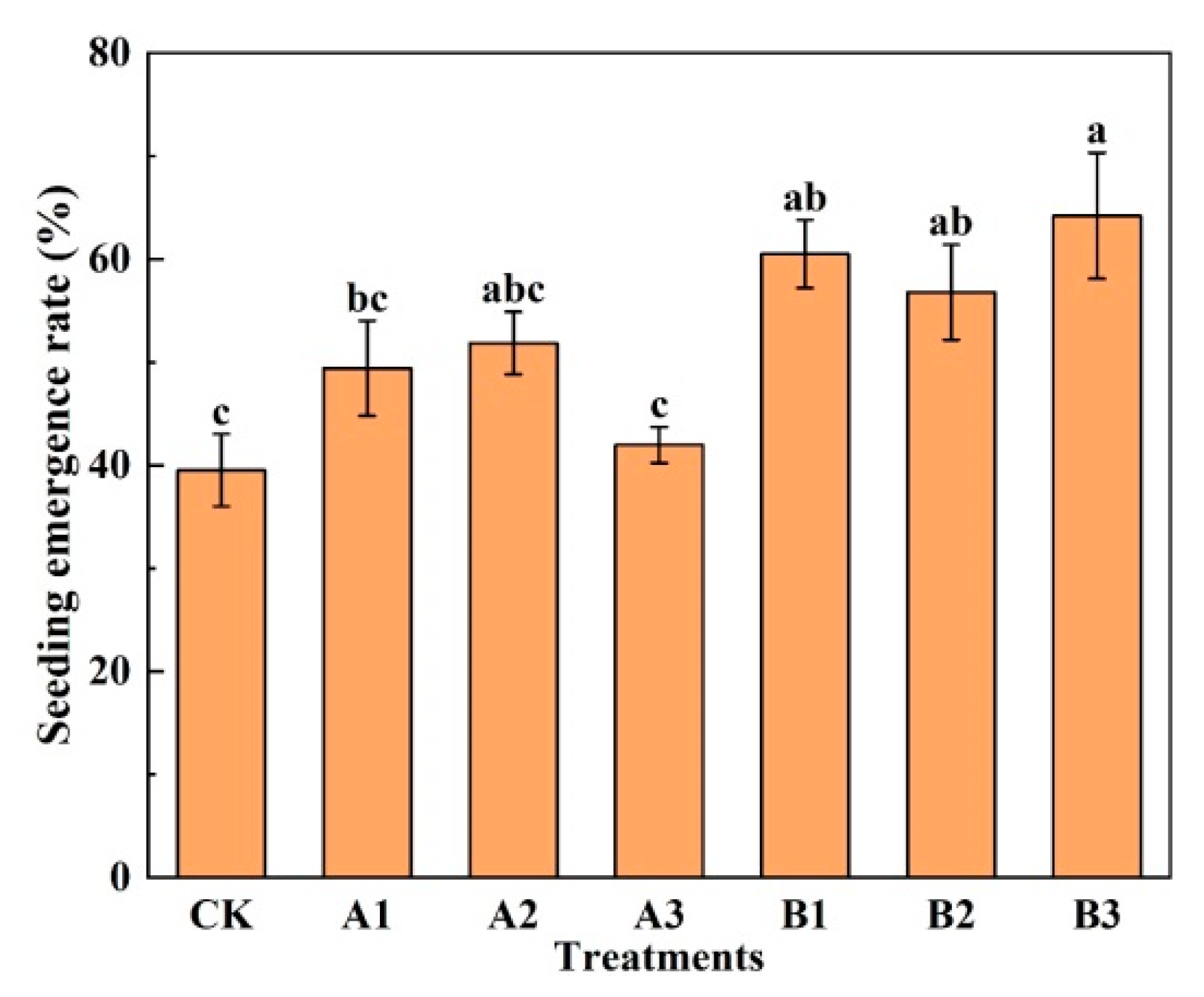
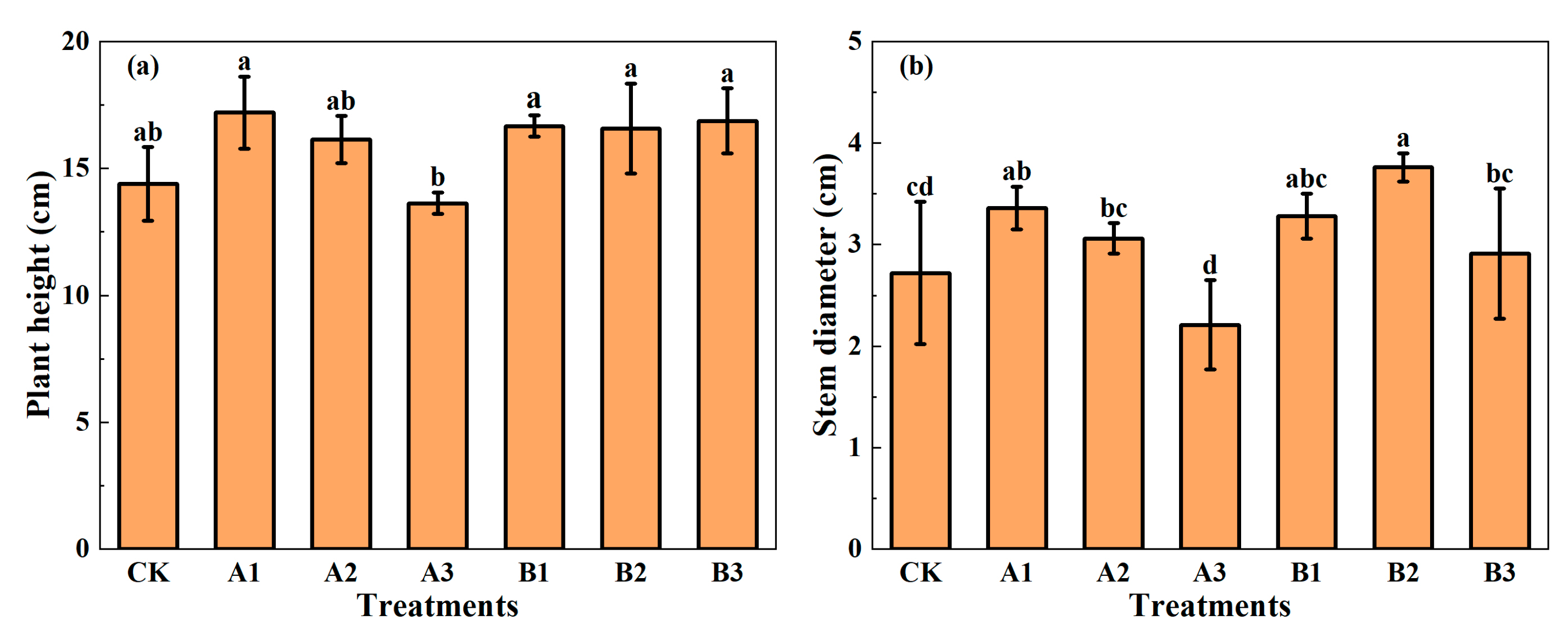

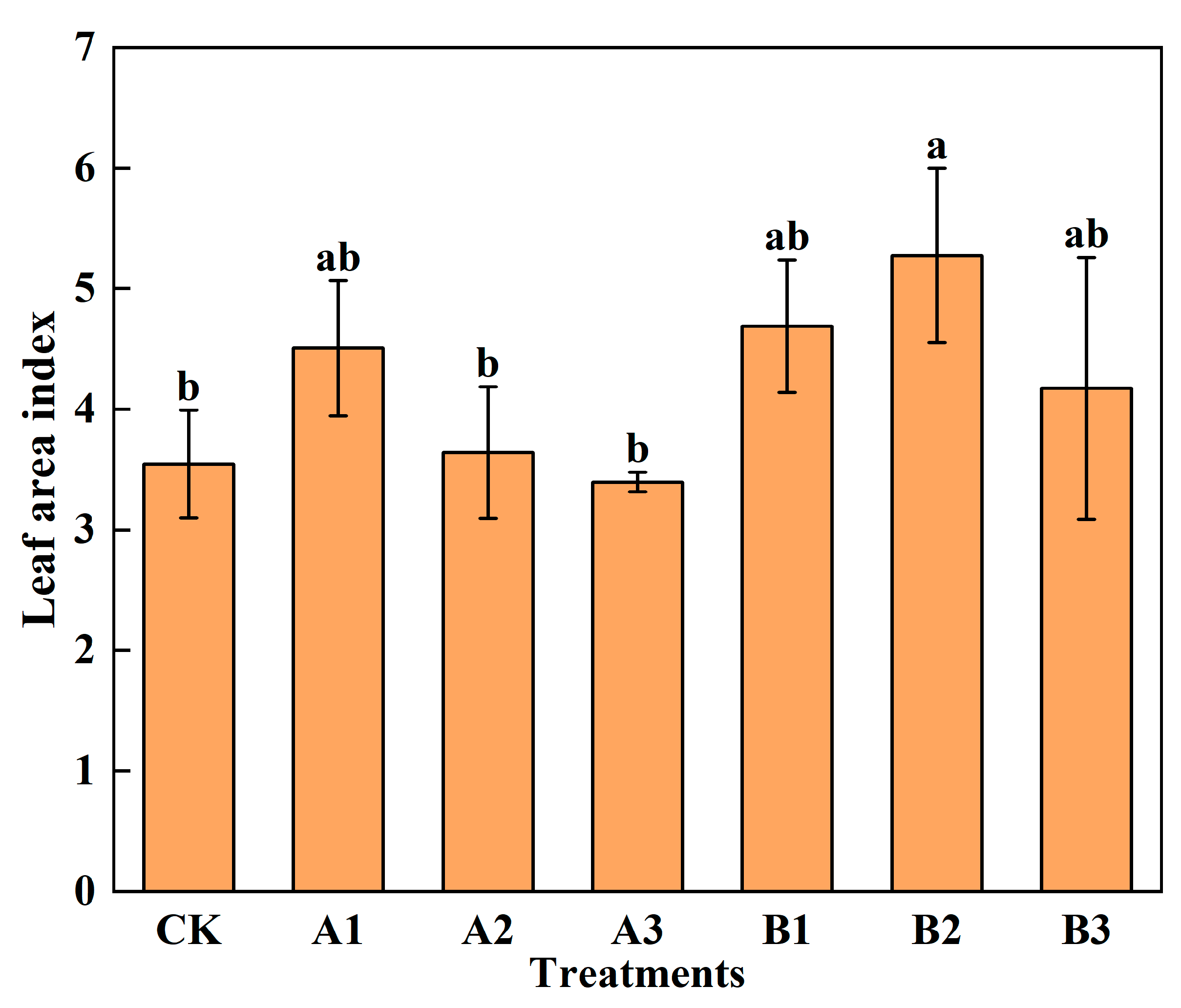
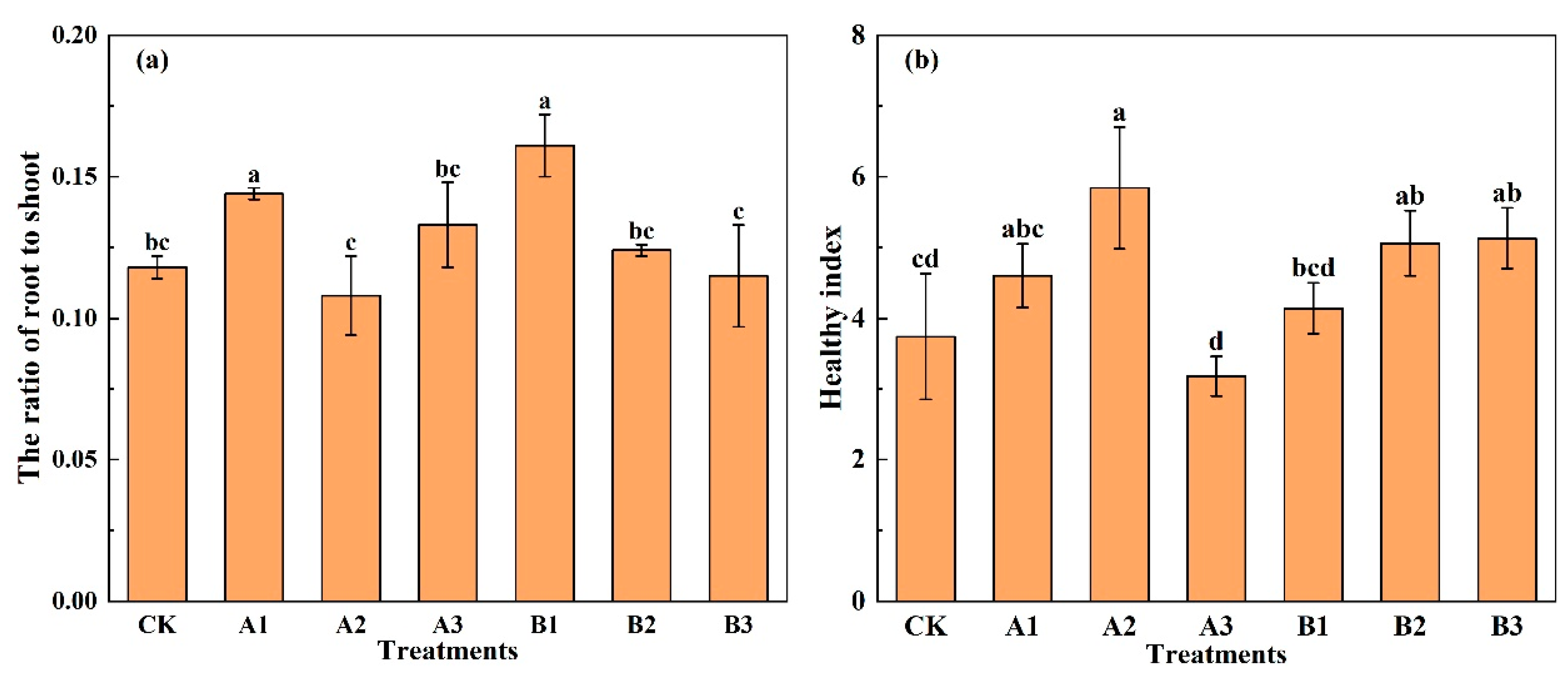
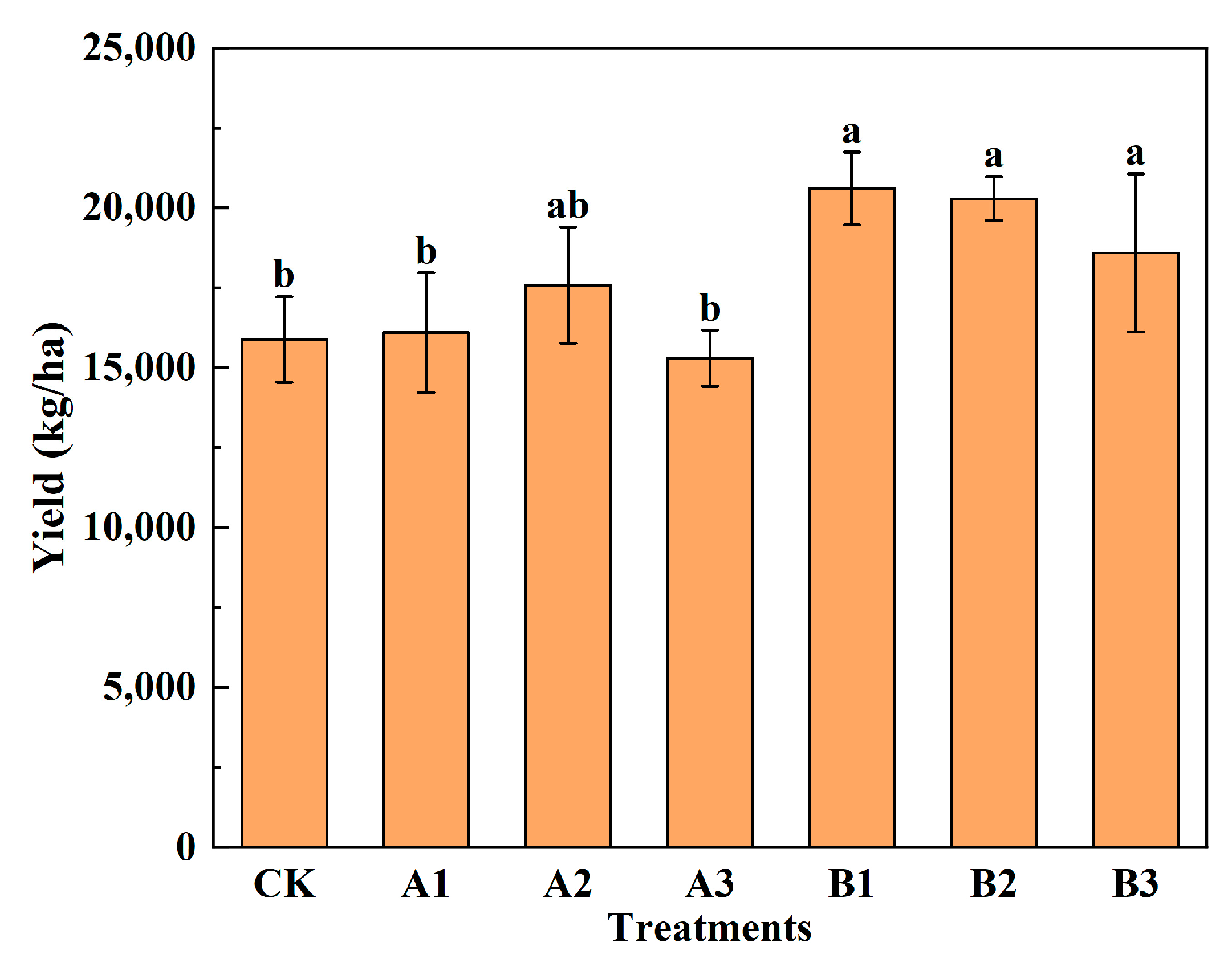

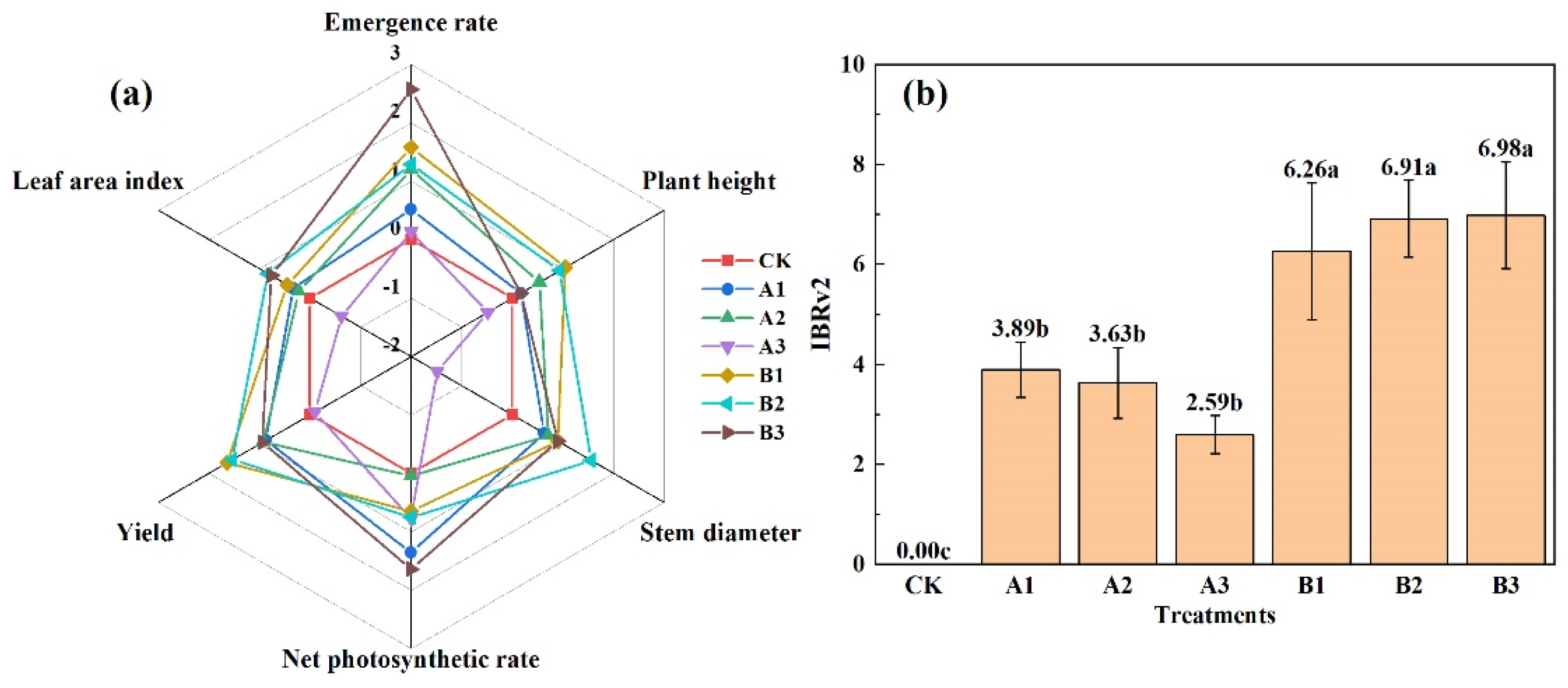
| Treatment | Total Irrigation Water Amount (mm) | ET (mm) | WP (kg/m3) |
|---|---|---|---|
| CK | 64.95 ± 1.94 ab | 66.40 ± 1.87 ab | 239.52 ± 28.09 b |
| A1 | 62.83 ± 1.86 b | 64.30 ± 1.72 b | 250.85 ± 21.04 ab |
| A2 | 66.18 ± 3.53 a | 67.78 ± 3.43 a | 260.36 ± 20.66 ab |
| A3 | 65.57 ± 0.56 ab | 66.95 ± 0.50 ab | 228.53 ± 16.98 b |
| B1 | 66.69 ± 2.52 a | 68.56 ± 2.43 a | 301.12 ± 18.52 a |
| B2 | 65.47 ± 3.20 ab | 67.31 ± 3.27 ab | 301.44 ± 3.45 a |
| B3 | 66.74 ± 1.22 a | 68.43 ± 1.07 a | 271.89 ± 26.67 ab |
| Treatment | Soluble Sugar (mg/g) | Soluble Protein (mg/g) | Nitrite (mg/kg) |
|---|---|---|---|
| CK | 8.27 ± 0.30 c | 1.72 ± 0.13 c | 1.50 ± 0.21 a |
| A1 | 9.86 ± 0.34 b | 1.87 ± 0.10 bc | 1.12 ± 0.08 ab |
| A2 | 9.35 ± 0.77 bc | 2.35 ± 0.08 a | 1.23 ± 0.21 ab |
| A3 | 6.96 ± 0.24 d | 1.93 ± 0.04 b | 1.25 ± 0.14 ab |
| B1 | 9.72 ± 0.45 bc | 1.80 ± 0.02 bc | 1.17 ± 0.15 ab |
| B2 | 10.23 ± 0.31 b | 2.20 ± 0.03 a | 1.02 ± 0.13 b |
| B3 | 13.92 ± 0.71 a | 1.93 ± 0.04 b | 1.19 ± 0.23 ab |
| Soil Bulk Density (g/cm3) | Field Capacity (%) | Soil Organic Matter (g/kg) | Available Nitrogen (mg/kg) | Water-Soluble Organic Carbon (mg/kg) | pH | EC (mS/cm) |
|---|---|---|---|---|---|---|
| 1.4 | 24.55 | 8.14 ± 0.07 | 15.66 ± 4.30 | <0.5 | 7.96 ± 0.01 | 2.02 ± 0.02 |
Disclaimer/Publisher’s Note: The statements, opinions and data contained in all publications are solely those of the individual author(s) and contributor(s) and not of MDPI and/or the editor(s). MDPI and/or the editor(s) disclaim responsibility for any injury to people or property resulting from any ideas, methods, instructions or products referred to in the content. |
© 2023 by the authors. Licensee MDPI, Basel, Switzerland. This article is an open access article distributed under the terms and conditions of the Creative Commons Attribution (CC BY) license (https://creativecommons.org/licenses/by/4.0/).
Share and Cite
Wang, J.; Shi, D.; Huang, C.; Zhai, B.; Feng, S. Effects of Common Biochar and Acid-Modified Biochar on Growth and Quality of Spinach in Coastal Saline Soils. Plants 2023, 12, 3232. https://doi.org/10.3390/plants12183232
Wang J, Shi D, Huang C, Zhai B, Feng S. Effects of Common Biochar and Acid-Modified Biochar on Growth and Quality of Spinach in Coastal Saline Soils. Plants. 2023; 12(18):3232. https://doi.org/10.3390/plants12183232
Chicago/Turabian StyleWang, Juan, Danyi Shi, Chengzhen Huang, Biyu Zhai, and Shaoyuan Feng. 2023. "Effects of Common Biochar and Acid-Modified Biochar on Growth and Quality of Spinach in Coastal Saline Soils" Plants 12, no. 18: 3232. https://doi.org/10.3390/plants12183232
APA StyleWang, J., Shi, D., Huang, C., Zhai, B., & Feng, S. (2023). Effects of Common Biochar and Acid-Modified Biochar on Growth and Quality of Spinach in Coastal Saline Soils. Plants, 12(18), 3232. https://doi.org/10.3390/plants12183232






